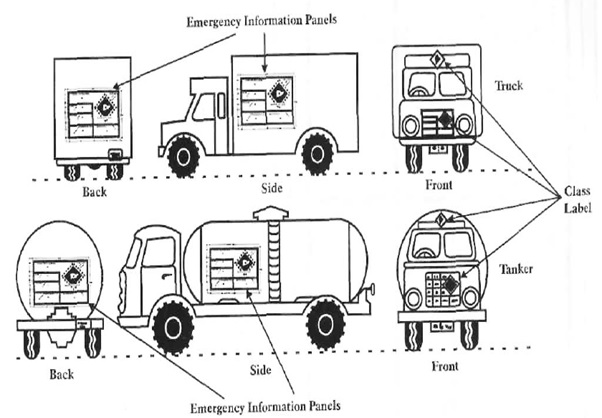

Rules regulating transport of Dangerous Goods by roads within India is promulgated through Hazardous Substances (Classification Packaging and Labelling) Rules, 2011 and The Central Motor Vehicles Rules, 1989.
Hazardous Substances (Classification Packaging and Labelling) Rules, 2011, gives exemption to pharmaceutical and cosmetic end products available in packages designated for consumer use and to dangerous goods required for the propulsion of the means of transport or the operation of its specialized equipment during transport.
Dangerous goods in packaged form domestically transported must be classified packaged, marked, labelled and the vehicle carrying the goods appropriately marked according to above said rules.
Salient points within The Central Motor Vehicles Rules, 1989 (CMVR, 1989)
Chapter II licensing of drivers of motor vehicles para 9 require drivers to be able to read and write at least one Indian language specified in the schedule VIII of the Constitution and English. The driver must successfully pass training from a recognized institute and his licence endorsed by the licencing authority.
As per section 129.2 Chapter V, Construction, Equipment and Maintenance of Motor Vehicles, every goods carriage carrying dangerous goods must be fitted with tachograph, (an instrument to record the lapse of running time of the motor vehicle; time speed maintained, acceleration, deceleration, etc.) confirming to the specification of the Bureau of Indian Standards
Vehicle owner’s responsibility, Section 132.2 Every owner of a goods carriage shall, before undertaking the transportation of dangerous or hazardous goods in his goods carriage, satisfy himself that the information given by the consignor is full and accurate in all respects and correspond to the classification of such goods specified in rule 137.
Information to driver, section 132.3, The owner of a goods carriage shall ensure that the driver of such carriage is given all the relevant information in writing as given in Annexure V of these rules in relation to the dangerous or hazardous goods entrusted to him for transport and satisfy himself that such driver has sufficient understanding of the nature of such goods and the nature of the risks involved in the transport of such goods and is capable of taking appropriate action in case of an emergency.
Route planning, section 132.4, The owner of the goods carriage carrying dangerous or hazardous goods, and the consignor of such goods shall lay down the route for each trip which the driver shall be bound to take unless directed or permitted otherwise by the Police Authorities. They shall also fix a time table for each trip to the destination and back with reference to the route so laid down.
Responsibility of driver, section 133 The driver of a goods carriage transporting dangerous or hazardous goods shall ensure that the information given to him in writing under sub-rule (3) of rule 132 is kept in the driver’s cabin and is available at all time while the dangerous or hazardous goods to which it relates, are being transported. Every driver of a goods carriage transporting any dangerous or hazardous goods shall observe at all times all the directions necessary for preventing fire, explosion or escape of dangerous or hazardous goods carried by him while the goods carriage is in motion, and when it is not being driven he shall ensure that the goods carriage is parked in a place which is safe from fire, explosion and any other risk, and at all times the vehicle remains under the control and supervision of the driver or some other competent person above the age of 18 years.
Emergency information panel: Every goods carriage used for transporting any dangerous or hazardous goods shall be legibly and conspicuously marked with an emergency information panel in each of the three places indicated in the Table below so that the emergency information panel faces to each side of the carriage and to its rear and such panel shall contain the following information, namely:—
(ii) the correct technical name of the dangerous or hazardous goods in letters not less than 50 millimetres high;
(i) the United Nations class number for the dangerous or hazardous goods as given in Column 1, Table 1 appended with rule 137, in numerals not less than 100 milimetres high;
(iii) the class label of the dangerous or hazardous goods of the size of not less than 250 millimetres square;
(iv) the name and telephone number of the emergency services to be contacted in the event of fire or any other accident in letters and numerals that are not less than 50 millimetres high and the name and telephone number of the consignor of the dangerous or hazardous goods or of some other person from whom expert information and advice can be obtained concerning the measures that should be taken in the event of an emergency involving such goods.
The information contained in sub-rule (1) shall also be displayed on the vehicle by means of a sticker relating to the particular dangerous or hazardous goods carried in that particular trip.
Every class label and emergency information panel shall be marked on the goods carriage and shall be kept free and clean from obstructions at all times.


Incident Report: The driver of a goods carriage transporting any dangerous or hazardous goods shall, on the occurrence of an accident involving any dangerous or hazardous goods transported by this carriage, report forthwith to the nearest police station and also inform the owner of the goods carriage or the transporter regarding the accident.
You may download following documents for reference and compliance.